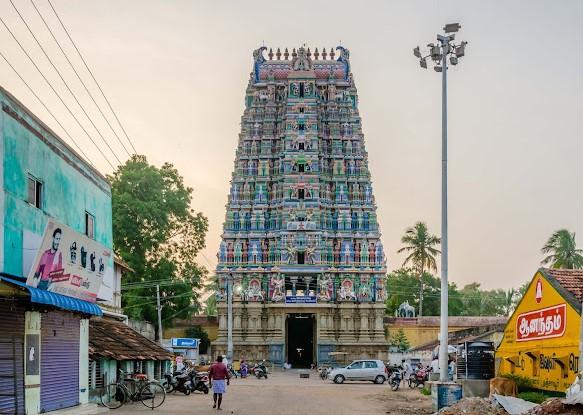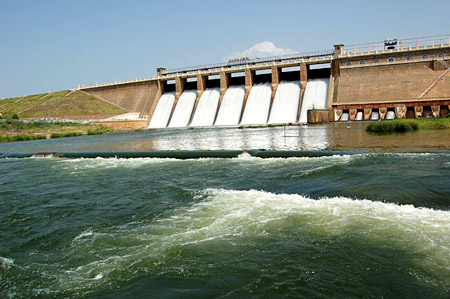The temple is believed to have been constructed by the Pandya kings, a dynasty renowned for their contributions to the culture and architecture of South India. There are four inscriptions found within the temple, which provide valuable historical insights. Two of these inscriptions are specifically dated to the reign of Pandya King Sundara Pandya, a significant ruler from the Pandya dynasty. These inscriptions likely shed light on the king’s patronage and the temple’s importance during his rule.
Currently, the temple is under the control of the Ramanathapuram Rajah’s family, which suggests a continued lineage of royal involvement in its upkeep and management. This connection between the temple and the local rulers adds to its cultural and historical significance, reflecting both the legacy of the Pandya kings and the later influence of the Ramanathapuram Rajahs.
PURANIC SIGNIFICANCE:
The Story Behind Thiruvadanai
Thiruvadanai, a sacred place in Tamil Nadu, derives its name from a fascinating legend involving Vaaruni, the son of Varuna, the God of Rain. The story begins when Vaaruni stayed at the Ashram of Sage Durvasa, who was deeply engaged in meditation. Vaaruni's friends, in their playful mischief, disturbed the sage by using the fruits and flowers from the ashram. Enraged by this, Sage Durvasa cursed Vaaruni, transforming him into a strange creature with the head of a goat (Aadu) and the body of an elephant (Yanai). Realizing his mistake, Vaaruni sought the advice of nearby sages, who recommended that he pray to Lord Shiva in the Pandya kingdom to reverse the curse.
Vaaruni followed their advice and approached the Lord at a temple in Thiruvadanai. Upon meeting Vaaruni in his Aja Gaja (goat-elephant) form, Lord Shiva inquired about his wish. Vaaruni requested that his story serve as a lesson to those who disrespect elders and that the place should be known as "Thiru Aadu Aanai" (Thiruvadanai) forever. The Lord granted his wish, and Vaaruni regained his original form after worshiping Lord Shiva. This incident led to the town being named Thiruvadanai, symbolizing the sacred place where Vaaruni, in his Aja Gaja form, regained his human form.
Adhi Rathneswarar - The Sun God’s Worship
The temple is also associated with Lord Surya (the Sun God), who was once very proud of his radiant power. However, when the brightness of Lord Shiva rose, Nandi, the bull vehicle of Shiva, drew it, causing the Sun to lose its radiance. Sun, realizing his diminished glow, turned to Nandi for a solution. Nandi advised him to worship Lord Shiva of Thiruvadanai, offering him a seat made of sapphire gems. Sun, being the leader of the nine planets, worshiped Lord Shiva, who came to be known as Adhi Rathneswarar. Legend has it that when abishek (ritual bath) is performed on the Lord, His form turns blue, signifying the power of the Sun’s worship.
Arjuna and the Pasupatha Asthra
Another significant legend involves Arjuna, one of the Pandava brothers. During the Pandavas' exile, Lord Shiva gave Arjuna the Pasupatha missile, a powerful weapon. The Lord instructed Arjuna to visit Thiruvadanai to learn how to wield this mighty weapon. As a mark of his devotion, Arjuna installed a shrine dedicated to Somaskanda in the temple. This worship not only blessed Arjuna with the knowledge to use the Pasupatha missile but also enriched the temple’s divine significance.
Vilvavanam and Other Names
Thiruvadanai is also referred to by several other names, reflecting its sacred and rich history. The town is believed to have been covered by a dense Vilva forest in ancient times, leading it to be known as Vilvavanam. The presence of this sacred forest is integral to the spiritual atmosphere of the place.
It is also said that a drop of nectar (Amrita) from Deva Loka fell at this spot, creating the very place of Thiruvadanai, further cementing its sanctity. Hence, the town is sometimes referred to as Mukthipuram, symbolizing the place of Salvation (Mukthi), where devotees who worship Lord Shiva can attain liberation.
Famous Worshipers and Beliefs
Many revered sages and divine beings are said to have worshiped Lord Shiva at this temple, including Sage Agasthya, Sage Brighu, and the immortal Sage Markandeya. Even the divine cow Kamadhenu is believed to have offered her prayers here.
Thiruvadanai is also known by several other names, such as Parijatha Vanam, Vilvavanam, Mukthipuram, Adhi Rathneswaram, Markandeyapuram, and Gomkuktheeswaram. Each of these names reflects the diverse aspects of the town's spiritual and historical legacy.
Thiruvadanai Through the Yugas
It is believed that Thiruvadanai has existed through all four Yugas-Satya Yuga, Treta Yuga, Dwapara Yuga, and Kali Yuga-remaining a place of spiritual significance and divine presence across time.
Legend and Mythology
- Sun Worship: The temple is closely associated with Surya, the Sun God. Surya worshipped Lord Shiva here to regain his radiance by installing the deity on a sapphire stage.
- Midday Abhisheka Phenomenon: During abhisheka at midday, the Lord’s lingam appears to turn blue, symbolizing divine brilliance.
- Masi Sun Rays: In the Tamil month of Masi, sunlight is said to fall directly on both the lingam and the deity of Goddess Snehavalli.
Cultural and Religious Significance
- Shukra Worship: Mother Snehavalli is considered the deity for Shukra (Venus). Devotees visit the temple to seek relief from Venus-related planetary afflictions.
- Murugan in Thirupugazh: The temple’s Lord Murugan has been praised in Thirupugazh hymns composed by Saint Arunagirinathar.
ADMINISTRATION:
The Temple is administered by the Hindu Religious and Charitable Endowments Department (HR&CE) of the Government of Tamil Nadu. This department oversees the management of temples, their funds, rituals, and related activities. The administration type is categorized as a government-controlled temple administration.


